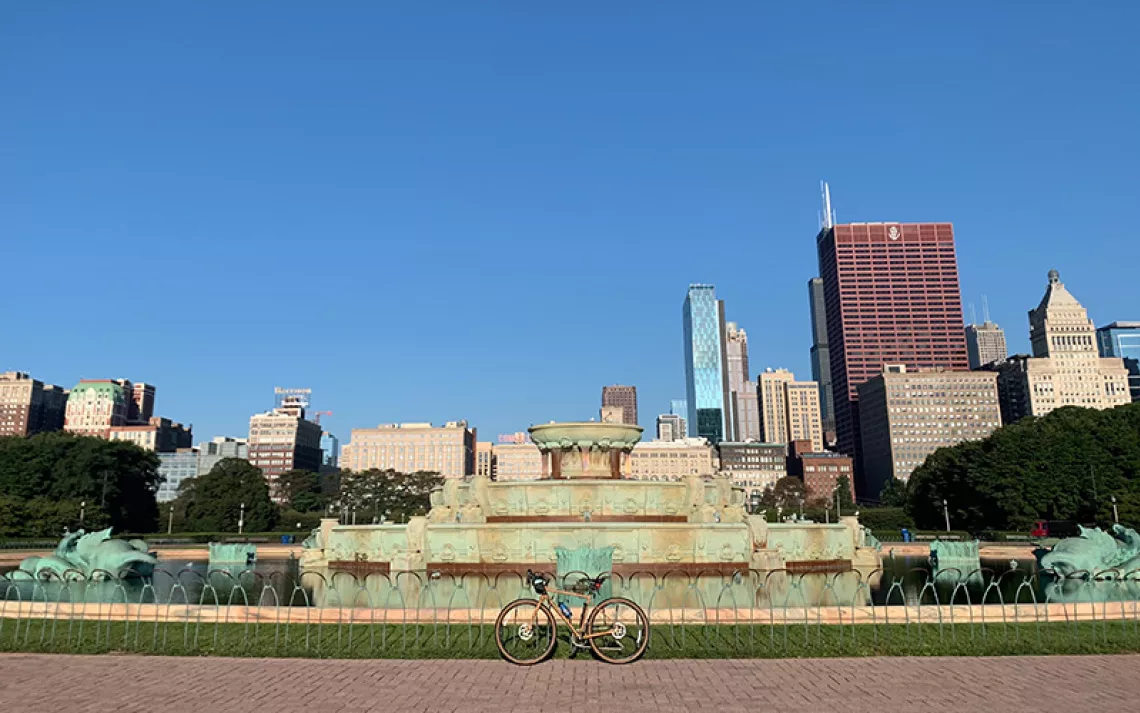Look, It's a Cheatercycle!
How a pedaling purist learned to love (or at least not be so embarrassed by) electric bikes

ON THE CRISP, SUNNY MORNING last December when I warily mounted an electric-powered bicycle for the first time, on a busy block in San Francisco, it was shaping up to be a day of personal growth and change. Feeding off a deep ideological and aesthetic ambivalence toward the bike, I scoped my surroundings for judgmental witnesses. A pair of skater boys executed tricks in a side street. Baby-faced telecommuters bearing chai lattes and laptops drifted in and out of the cafe on the corner. I felt their disdain come pouring along the concrete toward me.
Most likely, no one was paying any attention.
I was taking my virgin e-ride on the e-Moto Liberty 2.5, a bulky, electric-blue, seven-speed step-through cruiser with the sort of heavily padded saddle that makes you feel as though you are pedaling through a dream world of exhaust-flavored Jell-O, a world not designed for accomplishing anything. And yet, the Liberty made certain tasks substantially easier. Like gaining momentum. Like going up a 10-percent-grade hill. Like lazily pedaling through exhaust-flavored Jell-O and somehow achieving speeds of up to 15 miles per hour.
I made this discovery outside the garage of my first tutor in e-cyclery, Jeremy Kiefer, e-Moto's cycling-product manager. The Seattle company also sells the Liberty's sportier cousin the Velocity and a handful of other "power assisted bicycles"--a term covering both pedal-assist bikes like the Liberty, whose motors engage only when the cyclist exerts some energy by pedaling, and throttle-equipped bikes that give lazier riders an exertion-free, moped-style option. (The federal government regards both types of e-bikes as bicycles rather than motorcycles, as long as their top speed is limited to 20 mph; many manufacturers set an upper speed limit of 15 mph.)
Perched on the Liberty's sofa-cushion saddle, I gripped the handlebars, where a control panel alerted me to the level of juice left in the battery and offered a choice between standard mode and "Hi" power. (The latter would drain the battery more quickly, shortening its promised range of 35 miles.) With my upper half perpendicular to the asphalt, the transfer of energy from body to bike couldn't have been less efficient. On the plus side, I had a 37-volt battery lodged beneath the sofa cushion, powering a 250-watt brushless hub motor on the back wheel.
Kiefer patiently instructed me to turn the power on, which sounds intuitive but hadn't yet occurred to me. I opted for "Hi" and wobbled off the sidewalk. Half a pedal revolution and whoosh--I experienced a beat of whiplash as the motor kicked in and I bypassed the laptoppers and the skater boys and cruised up a hilly block with my pulse in neutral. It felt like being on an airport moving sidewalk. I wrestled a grin back into a straight line as I maneuvered experimentally through traffic for a few blocks, before returning to the relative safety of Kiefer's garage.
It was day one, hour one, of my adventure in electric bicycling--the brainstorm of a mildly sadistic editor who was curious to know if I, an ardent (and probably irritating) proselytizer of cycling as a way of life, could stomach spending several weeks commuting, erranding, recreating, and, most important, appearing in public on a mode of transportation that has become commonplace throughout large swaths of Europe and Asia and is gaining a toehold in the United States.
Not that you could tell in San Francisco, a city where cyclists are a recognized voting bloc but wiry '70s road bikes score highest on the style-quotient test (bonus points for no gears or brakes) and e-bikes are regarded, in the words of a guy at my local bike shop, as "the redheaded stepchild of the cycling industry." When I showed a friend pictures of some eye-opening exemplars, he had a kinder take, saying merely that he'd "rather see them than be seen on them." In the crowded arterial bike lanes of San Francisco, however, it would take a person of enduring serenity and fortitude to withstand the lip-curling judgment of one's peers.
It was my task to be that stalwart individual, which required stifling my own misgivings. I don't own a car. I ride my bike to work, to the grocery store, to cafes and bars and dinner parties. I've ridden from Seattle to Portland and from San Francisco to Los Angeles. And by bike, what I mean is bikes, three of them--a city bike, a road bike, and a cruiser--none of which come equipped with a battery, a motor, a turbo setting, or a torque sensor.
In my fondest daydreams, a crippling mechano-virus culls most of America's motor vehicles, clearing the highways for cyclists and mitigating a few pressing national problems. Meanwhile, a powerful mass-transit infrastructure somehow spreads like benign kudzu and enables our thoroughfares to become rivers of road bikes, racing bikes, mountain bikes, cruisers, recumbents, folding bikes, tandems, and cargos. In these daydreams, sharing the road is a pleasurable pastime. The more bikes, the better. But I can't say that I ever envisioned any of them meandering home to be plugged into a wall outlet alongside the toaster, the TV, or the washer-dryer.
"Oh," the man said brightly as he rolled up alongside me at a stoplight, fiddling with his cycling gloves and grinning. "It's a cheatercycle!"
KIEFER HAD RELINQUISHED THE KEYS TO THE LIBERTY (or rather, to its detachable battery pack--by far an e-bike's most valuable component) and sent me off into the world to try it out. I felt vulnerable. And not just because of snide comments. I was still getting used to navigating a motorized cruiser through the downtown chaos of buses, streetcars, enraged taxi drivers, jaywalkers, tourists, and drifting souls journeying through various stages of psychosis. Not to mention the wolf packs of commuter cyclists committing moving violations en masse. On another day, I would have been attached to one of the wolf packs. Instead, I coasted timidly in the wake of one, a low buzz emanating from my back wheel, and pondered this notion of cheating.
There was no doubt that the motor helped, flattening inclines and obviating the battle with inertia that accompanies every traffic stop. I basically stayed in two gears the entire week of my Liberty test ride--though initially I found myself gear-shifting out of nostalgia for the habitual call-and-response with my derailleur. (And as someone looking pensively ahead to a near-inevitable series of knee-replacement surgeries, I appreciated the e-boost.)
Still, when you're on a bike, you expect to work for things like tops of hills and their manifold rewards: a dazzling view, a feeling of sheer physical well-being, a fleeting sense of superiority. Sure, I've met hills where it would have been nice to press a button labeled "Hi" or "Sport" and be at the crest in the amount of time it takes to say "That was so exhausting I may puke." In the ordinary way of things, though, I'd do the hill, and with luck, my breakfast would remain in my alimentary canal. I could see how fellow cyclists might feel the new battery-powered me was skipping a few steps.
But surely a cleverer cheater could devise a more efficient method than a bike whose motor assistance and heft (the Liberty weighs 45 pounds) arguably come close to neutralizing each other. On certain stretches--anywhere flat, basically--I could barely keep up with nonmotorized bikers.
Of course, not all e-bikes are designed for weekend crawls along the boardwalk. The newly crowded market covers almost every category, from folding bikes like the Dahon Boost to mountain bikes like e-Moto's Ridge to cargo bikes like the Kona Electric Ute, which is capable of hauling hundreds of pounds. DIYers can convert their own bike with a kit from Currie Technologies or Bionx. And the British company Cytronex specializes in souping up high-end road bikes with a tiny motor and a battery that fits discreetly into a water-bottle cage; the results (unavailable stateside) weigh as little as 28 pounds--and cost more than $3,000. But Cytronex is an anomaly among a class of bicycles that tend to hover around 50 pounds. So the question became: If the electric bike's sheer weight mandated a leisurely pace, could I learn to roll with that?
Oddly, it was a guy who sailed cheerfully and motorlessly past me one morning on a fixed-gear road bike with a U-lock stuffed down his pants who helped me learn to love e-bikes. By now, I'd moved on to the commuter-style Giant Twist Express. Eric Doyne, the company PR guy who'd loaned it to me, had advised me to put the bike's torque sensor through its paces, since it actually had paces--owing to something called Hybrid Cycling Technology, I could incrementally coax more power out of the motor by increasing my own exertions. I felt this process begin at my first red light, as my foot on the top pedal caused the motor to rev slightly. When the light turned green, I shot forward, then stood in the saddle and flew along the thoroughfare. But the thrill was soon over. In my eagerness to wring out every last ounce of power, I kept hitting that 15 mph ceiling, whereupon the motor would cut out, leaving me irritably hauling on the pedals.

Sign up to receive Sierra News & Views
Get articles like this one sent directly to your inbox weekly.
With this action you affirm you want to receive Sierra Club communications and may vote on policy designated by the Sierra Club Board.
Enter cheerful fixie rider, crooning to his iPod, arms stretched overhead in a graceful asana, and maintaining an easy
pace, the cyclist's equivalent of a meditative stroll. I watched him and thought about what a delightful commute he seemed to be having, while the rest of us, teeth grinding, compulsively played Frogger amid the early-morning traffic. I recalled the comments I'd read online from e-bike owners kvelling over the joys of cycling to work without arriving all jacked-up and sweaty.
I decided to try it myself--to take advantage of the motor's gentle undercurrent without attempting to beat the rush. I adopted fixie's carefree stance (minus the hands-free yoga pose) and channeled my inner boardwalk cruiser. I glided along, pacing myself and letting the motor be my tailwind. It was startlingly difficult to resist shifting back into the frenzy of commuter strategizing, but I managed--and found my mood improving. I arrived at work slightly disoriented but fairly tranquil, and considerably less fragrant than usual.
"ARE YOU READY TO BIKE THE BRIDGE?!" the guy behind the counter at Blazing Saddles, a rental shop in Fisherman's Wharf, chirpily inquired on a sunny late-winter afternoon, before dispatching me along the tourist-trod path from Pier 39 to the Golden Gate Bridge, then down into the lovely bayside hamlet of Sausalito. I was soon toddling past a gaggle of Segway adventurers. My ride was the Ultra Motor A2B Metro, a 72-pound throttle-assist e-monster with 20-by-3-inch tires. It dwarfed the Liberty but was the truer illustration of a cheatercycle.
The Metro had two modes: I could turn the motor off and suffer through the experience of moving 72 pounds of bike through space and time, or I could use the throttle, which in most situations made the act of pedaling feel superfluous and feeble. I learned this when my first hill reared its asphalt head and then vanished behind me before I'd quite had time to process the event. On the bridge, where officials require e-riders to cut their motors, I learned what it felt like to opt for self-sufficiency on a bike that weighed as much as a baby hippo. It felt like driving with the emergency brake on, like all the cartilage in my knees was disintegrating, like I was biking the bridge not to Sausalito but to eternity. I thought about the other e-bikes I'd ridden. I wished one of them was there with me now so I could hug it.
In Sausalito, an older gentleman from Santa Clara admiringly circled the Metro and queried me on its wattage. He allowed that this particular model was less than ideal for hoisting onto a bus or train during commutes, but predicted that soon enough, maybe around the time gas reached $5 a gallon, we'd all be riding one or another of its kind.
As I motored back up the hill, pretending not to enjoy the painless ascent I'd panted through on countless other rides, I imagined sharing the road with more of these things. Looking out at the traffic jam clogging the bridge ahead of me, I could appreciate the Santa Clara man's prediction. A proliferation of e-bikes would, I knew, be good for the planet--provided their batteries were recharged in hydropower-rich places like Seattle, rather than in coal-dependent places like Atlanta.
The bridge stands at the western edge of a country enraptured by its 250 million automobiles, where barriers both psychological and infrastructural have largely kept bike use from becoming more than a recreational pursuit. No amount of portable wattage will fix the problem of not enough bike lanes. But the extra hardware on e-bikes, aside from making them--I have to admit--kind of fun, might just seduce potential riders who are afraid of hills, or of arriving at the office drenched in sweat, or of going into cardiac arrest while hauling kids around on a cargo. In which case, electric bikes could help to dampen the nation's enthusiasm for the internal combustion engine. I'd have to tweak my fondest daydream, of course--the one in which most people power themselves through the world--but that's a compromise I could live with.
 The Magazine of The Sierra Club
The Magazine of The Sierra Club



